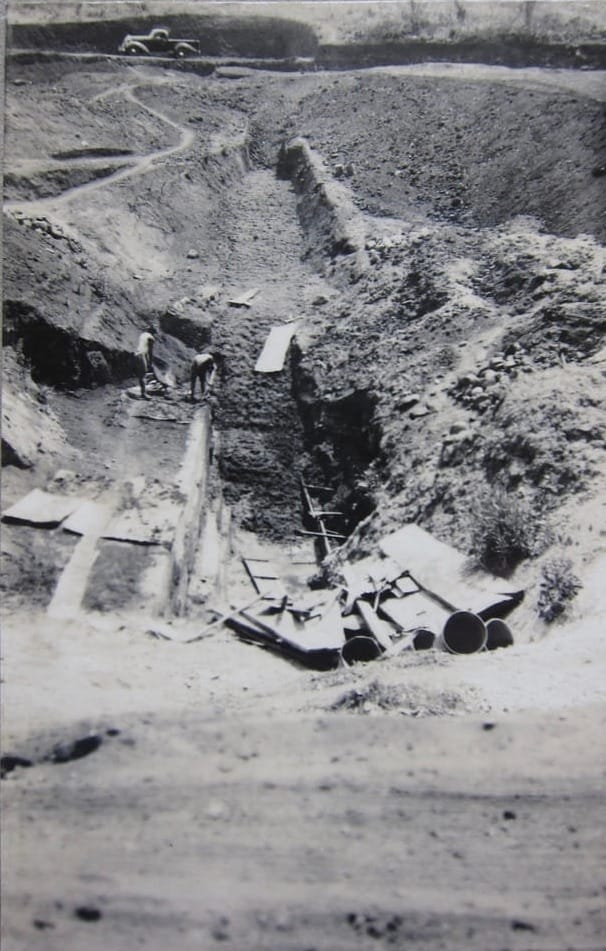The Big Dig
Edgar found the perfect site for a dam not four hundred yards behind the house.

There was a valley into which the big streams that drained the Haunted Forest ran together with three tributaries entering the upper part of the valley which was the flattest bit of land on the farm. The streams joined about thirty yards in front of the site of the dam wall and there was a deep stream-bed which over the years had gouged a hole about six feet deep in the surrounding land. The valley to be flooded by the dam was a dangerous bog where he had already lost three or four cows in the dry season when the grass in the valley of the dam looked invitingly green. He had had to fence off the whole area.
From the get-go Edgar knew this was going to be a big project. He sought the advice of Umtali's Chief Irrigation Engineer.
On his advice, Edgar sunk trial pits to find suitable clay to build clay cores for the dam. They started out digging a trench in fairly loose materials, but as time went on they got down to round boulders. The length of the wall was one hundred and ten yards. Periodically, the engineer came to inspect as they went down, down, down making a larger and larger excavation. Each time Edgar hoped he would hear that he had gone deep enough, but repeatedly the engineer said, "I'm sorry..."
As soon as Edgar sold his seven old oxen for £5 each, trouble began. There were no spares and the extra long period of very hot weather pulled the oxen down in condition. He really wanted another eight very badly as well as two more dam scrapers which would give him twenty-four oxen to work six scrapers so they could work alternate days.
Approval from the engineer eventually came at twenty-two feet below the stream bed. Every now and again the material would slide into the trench and apart from adding tremendously to the work, it was very dangerous for the workers. The rule then was that one would never ask an African to take any risk which one was not prepared to face oneself. So either Edgar or Ferguson was always at the bottom of the trench in case danger was imminent and urgent evasive action needed to be taken. A particularly sudden slip did occur; a worker buried! Swiftly digging him out he suffered no serious injury and was revived with a little neat whisky.
Month after month they continued digging operations until finally, with the help of explosives in removing the larger boulders they found bedrock granite on one side under the stream and very stiff clay on the other. The bedrock was about six feet under the bottom of the boulder strata which they had cleared and water was now seeping into the trench for about thirty yards. In addition, the main stream was falling in a cascade onto the bedrock. A narrow escape trench through the downstream wall of the evacuation was opened up to carry this water back to the stream below the dam site.
At last the engineer said, "Alright you have gone far enough. You can start filling in the trench."
Originally Edgar had hoped that he could fill the evacuation with clay, but the underground water was far too plentiful. Concrete was an unexpected, but necessary, expense until they were above the underground water level.
Edgar had recruited a special gang of forty workers for the dam building. Now, a considerable number of them sat all day breaking up granite boulders. Sand from the river bed two miles away was collected in a scotch cart pulled by ten oxen. The only thing he purchased was the cement.
Working from both ends of the wall towards the center they sealed off all the water except for the main stream passing through a gap about three feet wide and six feet high which was tumbling into a pool in front of the wall.
The underground work on the dam had been nearly half the job. Still, progress was intermittent as the oxen and the labor force were often needed for other purposes on the farm. But whenever there was a slack period he raised the wall a little higher. All the material from the flat ground in front of the wall for construction purposes further increased the storage capacity of the dam and made a temporary spillway to protect the work.
The stream was very low and the dam was progressing steadily but Edgar knew that the dry season was coming to a close. Once the rains set in it would be too muddy for the oxen to work and the workers wouldn't get their piecework done because it would be too sticky for the wheelbarrows.
Time was of the essence. Edgar installed a four inch pipe, encased throughout in concrete, right through the wall so that water would be available for irrigation even when the dam was far below full. They built a coffer dam of planks between the pool and the gap after stacking on the edge enough material to fill the gap up to the level of the two sides. Just before the rains started the concrete filling of the trench reached higher than the underground water throughout, with the reward of finding fifteen or sixteen springs shooting up vertically in front of the wall.
Finally, the engineer expressed great satisfaction on the big dig. He showed Edgar how to make the roughened joints between the concrete core and the clay so that the water could not penetrate the join. The clay work commenced.
The historical novel Whitewashed Jacarandas and its sequel Full of Possibilities are both available on Amazon as paperbacks and eBooks.
These books are inspired by Diana's family's experiences in small town Southern Rhodesia after WWII.
Dr. Sunny Rubenstein and his Gentile wife, Mavourneen, along with various town characters lay bare the racial arrogance of the times, paternalistic idealism, Zionist fervor and anti-Semitism, the proper place of a wife, modernization versus hard-won ways of doing things, and treatment of endemic disease versus investment in public health. They are a roller coaster read.
References:
- By permission, sourced from Sir Edgar Whitehead's Unpublished Memoirs, Rhodes House, Bodleian Library, Oxford University.
- Photo credit: By permission, Sir Edgar Whitehead's Unpublished Photograph Albums, Rhodes House, Bodleian Library, Oxford University.

